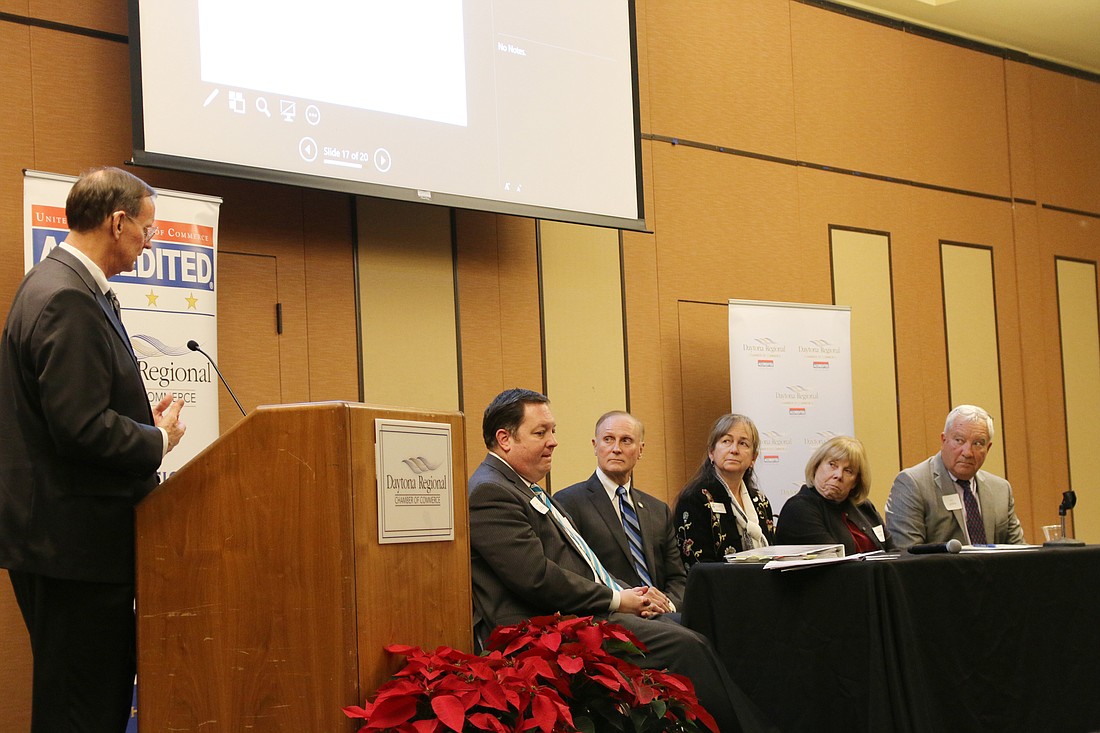- April 26, 2024
-
-
Loading

Loading

In a county of over 530,000 people, where an estimated 42% live paycheck to paycheck, and the number of minimum wage jobs available continues to increase, speakers at the Daytona Regional Chamber of Commerce Tallahassee Speaker Series arrived at the same conclusion: Volusia County needs more affordable housing
“It’s not right to say to a person that you can work here, but you can’t live here because you can’t afford to live here,” Daytona Beach Mayor Derrick Henry said,
But there are hurdles Volusia needs to overcome. Speakers at the event, held at Daytona State College on Thursday, Nov. 29, highlighted three major obstacles in creating affordable housing — finding affordable land, obtaining tax credits and funding, and battling the "Not in My Backyard" mentality.
Henry said, that while Volusia as a whole has been working to attract and retain companies with high-paying positions, like Brown & Brown, the reality is that a majority of the population works in the service and tourism industry. He added that. sometimes, the community believes affordable housing will hurt Volusia's economic development.
It's the opposite, Henry said.
“If we fail to meet this demand, then we will fail to be able to attract the type of jobs that we’ve already been attracted," Henry said.
While he explained that saying something like that sounds good, and feels good for him to say, Volusia needs to figure out how to actually do it.
Affordable land is hard to find, said Larry McDermott of Intracoastal Bank, and that's why most new developments are happening on the west side of the county.
The problem with going out west for a developer interested in building workforce housing units? Lack of public transportation. And when an affordable housing development is proposed in a convenient location, it often faces backlash from people who don't want it in their community.
“No one seems to want an affordable housing project either adjacent or in their own housing area," McDermott said. "That NIMBYism is going to be a real factor over the future if we try to put projects in a core area.”
This happened in Ormond Beach over a year ago.
On Sept. 19, the City Commission approved 4-1 a rezoning change to allow developer Paul Holub to build a 100-unit workforce apartment complex, to be known as the Tomoka Estates apartments, west of I-95 at 275 Interchange Blvd. About 50 people attended that meeting, five of which were resident vehemently opposed to the project. However, the development was unable to get a low-income tax credit by the state, and fell through.
Now, a 124-room four-story Extended Stay America is being proposed for the property.
Workforce housing can't happen without subsidy, said Fran Gordon, executive director of Mid-Florida Housing Partnership —regardless of whether it comes from the federal government, state legislature, the county or the municipalities themselves.
“The subsidy has to come from somewhere," Gordon said.
A lot of that subsidy relies on the 1992 Sadowski Act, which created a dedicated source of revenue for housing via a 10-cent increase on documentary stamp taxes on real estate transfers. Trey Price, the Florida Housing Finance Corporation's Executive Director, said 30% of the dedicated money flows into the State Housing Trust Fund and 70%into the Local Government Housing Trust Fund.
It also funds programs like the State Housing Initiatives Partnership, known as SHIP. In Volusia, three entities have access to this: the cities of Daytona Beach and Deltona, and Volusia County itself.
The Florida Housing Finance Corporation receives about 170 applications for affordable housing funding a year, but it can only help build around seven to 10. They don't get a lot of applications from Volusia County though, he said, likely because of high land costs and zoning restrictions.
“So, there’s a lot that don’t get funded, and so sometimes it’s a little luck of the draw," Price said.
But with about $300 million in the state's Sadowski fund, where is most of that money going?
District 9 State Sen. David Simmons said that, while some portion of that fund is solely dedicated to housing, not all of it is. Legislature can use some for general spending needs or to transfer to the Budget Stabilization Fund.
He said $182 million of the Sadowski funding was "swept" by legislature last year. There are other demands and issues, he explained, such as water quality and health care.
“That’s not to say that affordable housing is not important," Simmons said. "It is. It is critical.”
He suggested residents contact their local representatives to communicate the need for workforce housing.